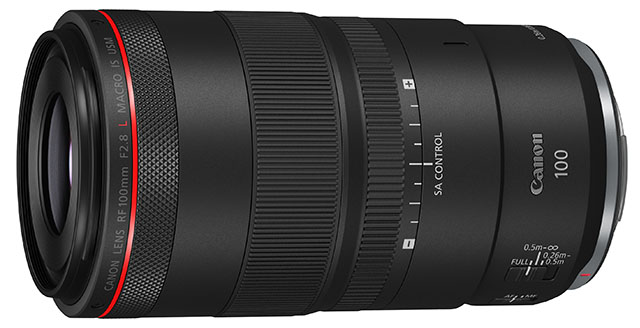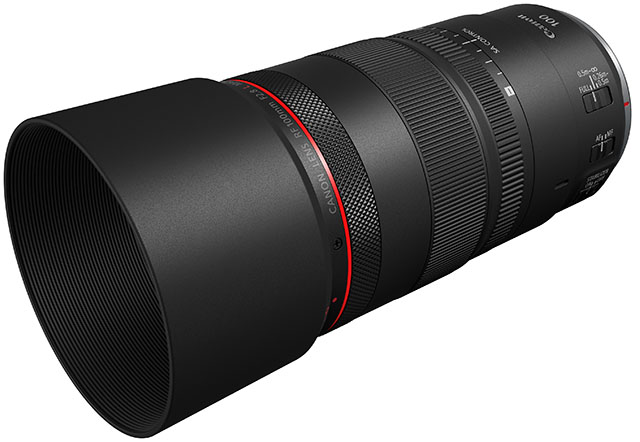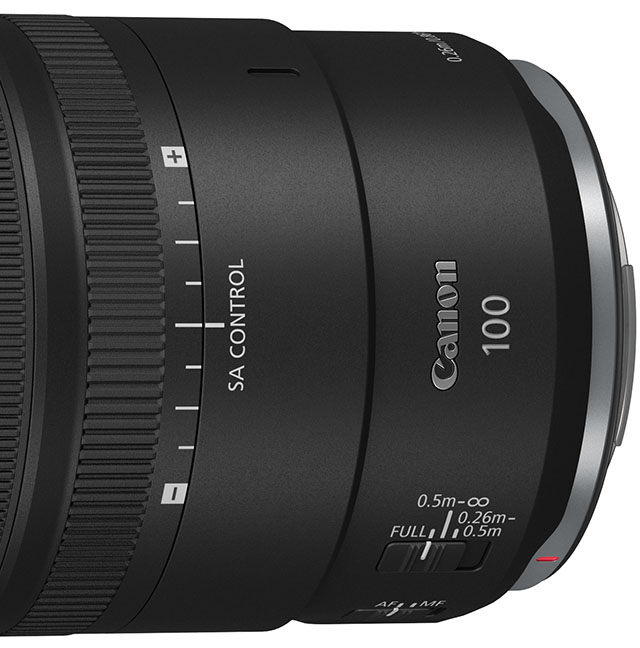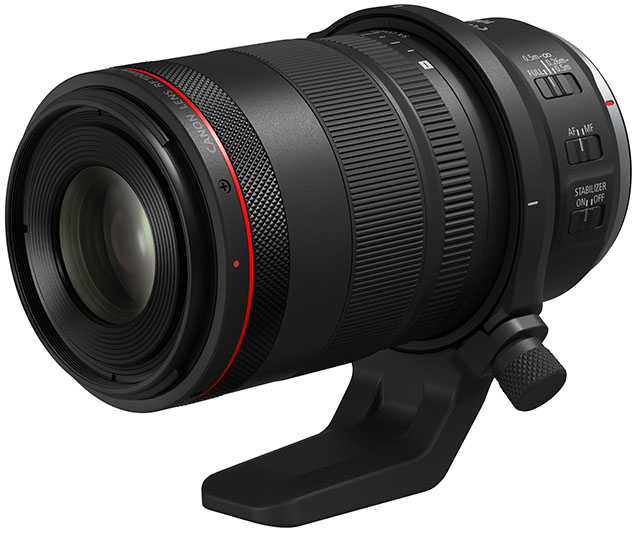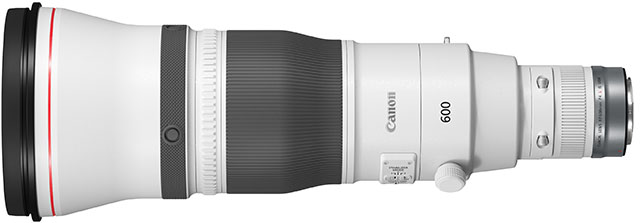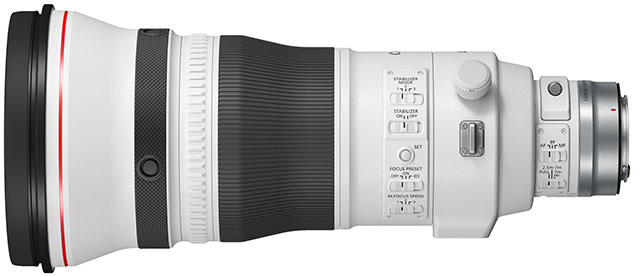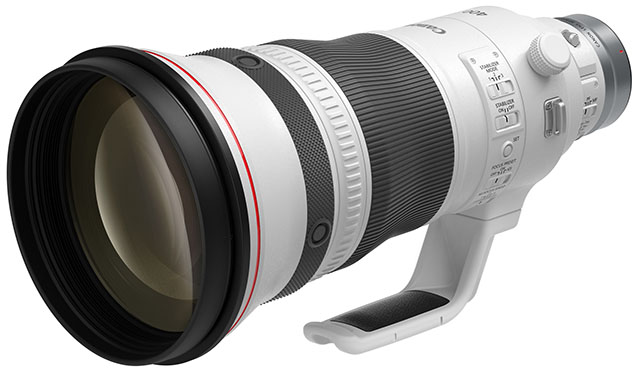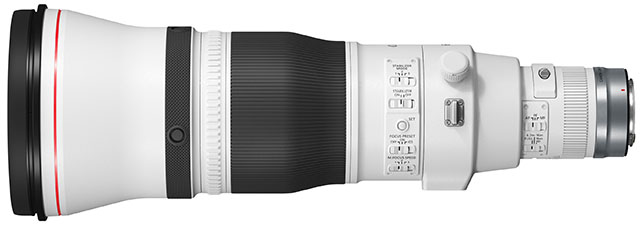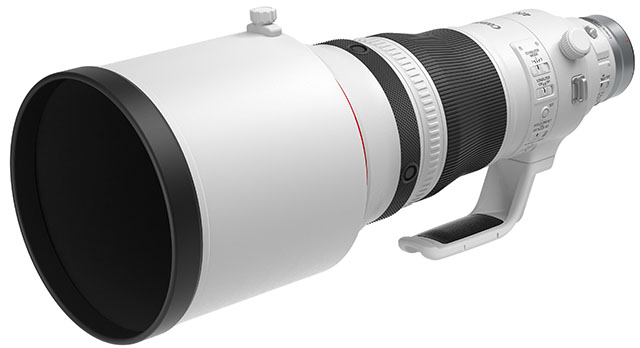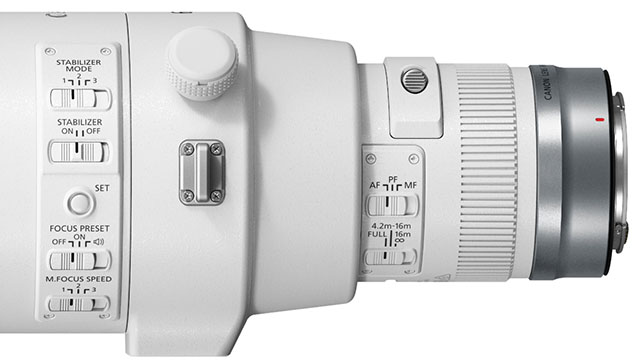Canon announces three RF lenses: 100mm f/2.8 L Macro IS, 400mm f/2.8 L IS & 600mm f/4 L IS
posted Wednesday, April 14, 2021 at 12:00 AM EDT
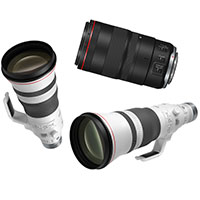
Canon has announced three high-end prime L-series lenses for its mirrorless RF mount. The shortest of the three primes is the RF 100mm f/2.8 L Macro IS USM lens. The other two lenses are RF-mount versions of two existing super-telephoto lenses, the RF 400mm f/2.8 L IS USM and RF 600mm f/4 L IS USM.
Canon RF 100mm f/2.8 L Macro IS USM
Taking the lenses in turn, let's start with the new macro lens. It is the first Canon RF lens specifically designed for macro photography. Further, a key feature that sets the new RF macro lens apart is that it's Canon's first medium telephoto macro lens with a maximum magnification of 1.4x.
The impressive magnification is greater than most full-frame macro lenses, which typically offer 1x max magnification. At 1.4x magnification, the minimum focusing distance is 10.2" (0.26m), and the working distance is 3.4" (8.6 cm). At 1x magnification, the focusing range is 11" (0.28m), and the working distance is 4.4" (11.2 cm).
Autofocus is driven by a high-speed Dual Nano USM system. Canon promises quiet autofocus and reduced focus breathing. With built-in optical image stabilization, Canon also promises a steady lens. The optical stabilization offers up to 5 stops of shake correction. The optical IS can also be combined with in-camera image stabilization to deliver up to 8 stops of shake correction (as tested on a Canon EOS R5). The hybrid IS system helps compensate for angular and shift camera shake during macro shooting as well.
The RF 100mm f/2.8 L Macro IS USM has 17 elements in 13 groups. The lens includes Super Spectra Coating, and there's a fluorine coating on the front element. The lens is 5.8" (148mm) long without its included lens hood and has a maximum diameter of 3.2" (81.5mm). The lens weighs 25.8 oz. (730g).
Like other RF lenses – save for the new RF 400mm and RF 600mm lenses – the RF 100mm f/2.8 L Macro IS USM lens includes a control ring for making immediate changes to settings including exposure compensation, shutter speed, aperture or ISO. The lens is also dust- and weather-resistant, thanks to weather sealing at the lens mount, focus ring, control ring, SA control ring, switch panel and switches.
The RF 100mm f/2.8 L Macro IS USM also includes a second control ring, the spherical aberration (SA) control ring. Canon states this the SA control ring "allows users to change the character and appearance of the bokeh and obtain a softer focus effect with a simple turning of the ring to the desired result." At the neutral setting, bokeh is as users expect. However, if you rotate the SA ring to the + setting, bokeh is more bubbly and includes harder edges. On the other hand, rotating the SA ring toward -, the image is softer and has less pronounced edges.
The SA control ring is not like the APO filter in the RF 85mm f/1.2 L USM DS lens. Instead, the SA control ring moves the floating lens element. The effect of the SA control ring and the amount of change in spherical aberration vary significantly as focus distance changes. For example, at 0.26m, when maximum magnification is 1.4x, the SA ring has no effect. Per Canon, the largest impact is at focusing distances between 0.38m and 1m.
The Canon RF 100mm f/2.8 L Macro IS USM is expected to arrive this July with an estimated retail price of $1,399 USD.
Canon RF 400mm f/2.8 L IS USM and RF 600mm f/4 L IS USM
The RF 400mm f/2.8 L IS USM and RF 600mm f/4 L IS USM lenses are essentially the same as their EF counterparts, the EF 400mm f/2.8 L IS III USM and EF 600mm f/4 L IS III USM. The new RF lenses, which are targeted at pro wildlife and sports photographers, feature the same design as the EF lenses save for the mount. Per Canon, the change in mount doesn't result in any noticeable change to image quality or autofocus performance. Still, by using a native version, the overall setup is more reliable and durable. It stands to reason that by eliminating the need for a lens adapter, the overall kit is more structurally sound and includes better sealing. Especially considering that super-telephoto lenses are large and heavy, Canon argues that it's better to eliminate the need for an adapter.
While there's no change in the optical design, there is a very slight change in weight for both the RF 400mm and RF 600mm compared to their adapted EF counterparts. The RF 400mm f/2.8 L IS USM weighs 6.37 lbs. (2,890g) versus 6.5 lbs. (2,950g) for the EF version with the EF-EOS R mount adapter. The RF 600mm f/4 L IS USM weighs 6.81 lbs. (3,090g), whereas the adapted EF version weighs 6.97 lbs. (3,160g). It's worth noting that because Canon has changed only the mount for the new RF super tele lenses, they are the first RF lenses not to include a control ring.
While the design is identical, there is a minor cosmetic change with the new lenses. The EOS R system has extended lens mounts, which are dark silver. To create a coherent visual identity, RF lenses include silver at the mounting area as well. The RF 400mm f/2.8 and RF 600mm f/4 lenses include silver at the mounting area to keep this look consistent. Other than this, the EF and RF lenses are practically indistinguishable. This means that the RF lenses also include infrared reflective pigments with high reflectance and titanium oxide lens barrel coating with silica, providing UV resistance and heat reduction. Put another way, the RF super tele lenses have the classic light gray 'Canon' color.
Both lenses include Canon's Super Spectra Coating (SSC) and Air Sphere Coating (ASC) to minimize ghosting and flare. The electronic focusing ring is customizable and includes manual focus capability during Servo AF. There are focus preset buttons, focus range limits, and optical image stabilization mode switches on each lens. Each lens includes dust- and water-resistant construction.
The RF 400mm f/2.8 and RF 600mm f/4 lenses are compatible with Canon's RF 1.4x and RF 2x extenders. The RF 400mm f/2.8 becomes a 560mm f/4 lens with the 1.4x extender and an 800mm f/5.6 lens with the 2x extender. The 600mm f/4 lens becomes an 840mm f/5.6 and 1200mm f/8 with the 1.4x and 2x extenders. In each case, autofocus and IS functionality remains possible, even in the case of the 1200mm f/8.
The RF 400mm f/2.8 L IS USM and 600mm f/4 L IS USM lenses have identical specifications to their EF counterparts. The RF 400mm f/2.8 has a minimum focusing distance of 8.2' (2.5m), which results in a 0.17x maximum magnification. The lens has 17 elements in 13 groups, including two fluorite lenses and one super ultra low dispersion (UD) lens element, which Canon says significantly improves optical performance and controls chromatic aberration. To deliver smooth bokeh performance, the lens includes a rounded nine-blade aperture diaphragm.
Autofocus is provided via a ring-type USM autofocus system. The lens includes optical image stabilization, which provides up to 5.5 stops of shake correction. The RF 400mm (and RF 600mm) do not coordinate with in-body image stabilization to provide improved image stabilization performance, something the new RF 100mm f/2.8 Macro lens offers.
The RF 400mm f/2.8 has a minimum length of 367mm, which is, of course, increased when using the included ET-155 lens hood. The maximum diameter is 163mm. The lens includes a 52mm drop-in filter holder, which comes with the lens and includes a standard protective filter. The lens also includes a detachable tripod mount, which can be replaced with an optional smaller monopod mount. Additional optional accessories include a shorter lens hood and a drop-in circular polarizing filter.
The RF 600mm f/4 is a bit longer, with a minimum length of 472mm. The lens is also slightly larger and has a maximum diameter of 168mm. Optically, the RF 600mm f/4 L IS USM also includes 17 elements in 13 groups, including a pair of fluorite elements and a single super UD element. The lens has a minimum focusing distance of 13.8' (4.2m), which results in a max magnification of 0.15x.
Like the RF 400mm f/2.8, the RF 600mm f/4 has a ring-type USM autofocus system and includes optical image stabilization, which promises up to 5.5 stops of shake correction. Also, like the 400mm lens, the 600mm super tele has a nine-bladed rounded aperture diaphragm.
The RF 600mm f/4 L IS USM lens also includes a 52mm drop-in filter holder and comes with a tripod foot and lens hood. The RF 600mm f/4 also has an optional monopod foot accessory, and a shorter lens hood is available. Both lenses come in a soft lens case.
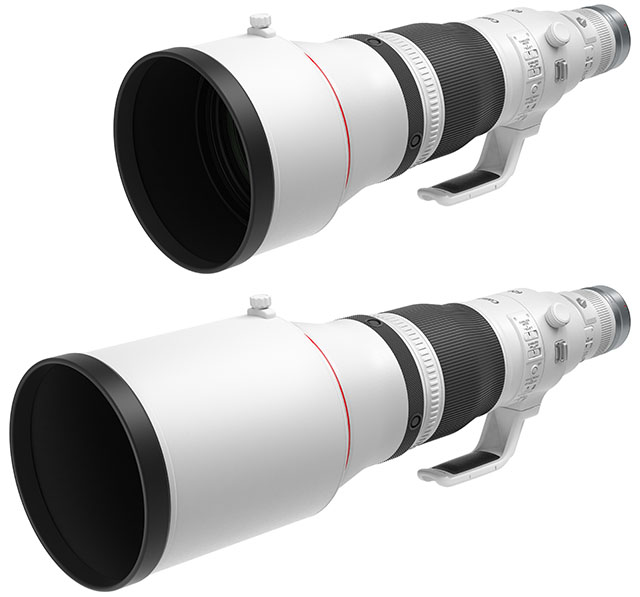
The Canon RF 400mm f/2.8 L IS USM has the same suggested retail price as the latest EF version, which is $11,999 USD. Likewise, the RF 600mm f/4 L IS USM has the same price as its EF counterpart, at $12,999. Canon expects both lenses to be available starting in July.
